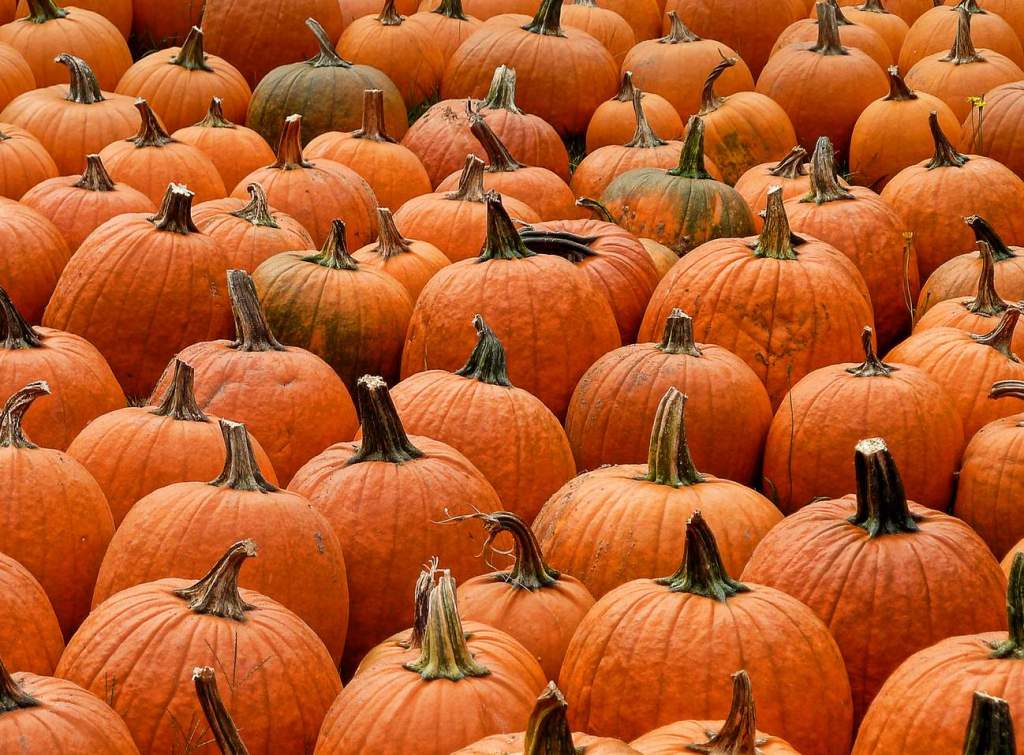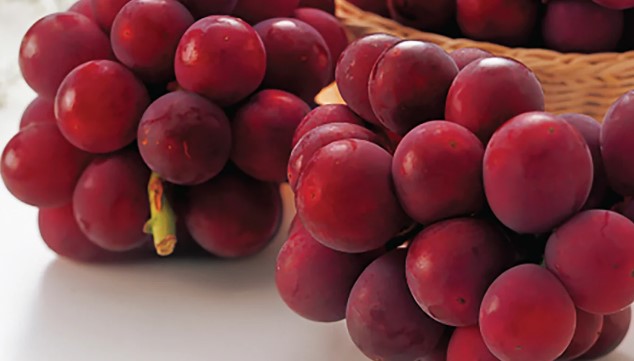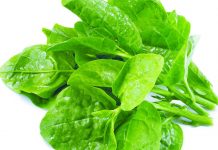Description: Pumpkin fall into two groups: one (Cucurbita pepo), includes the common summer and autumn pumpkins and the bush pumpkins, and the other (Cucurbita moschata), embraces the winter crookneck or crushaw pumpkins. That pumpkins are closely related to their cousins the squashes (Cucurbita maxima) well illustrated by the fact that many pumpkins, such as the Pattypan and Summer Squash, are commonly called squashes. The difference in foliage and fruit characteristics of the two pumpkin species as contrasted with squashes should be clearly noted.
Pumpkins have coarse, harsh, large, deeply lobed, or entire leaves on bushy or trailing vines. The flowers are born singly in the axils of the leaves on long stalks and are either staminate (male) or pistillate (female). The flowers are large and funnel-shaped, with orange-yellow petals. Hence, the fruits vary tremendously in size, shape, and color. The seeds are flat and oblong, with a gentle taper toward either end. Pumpkins are native to Tropical America, as are squash.

Types and Varieties: Pumpkin varieties may conveniently be grouped into eight types, as follows:
CONNECTICUT FIELD: Pumpkin group (Pepo). Running vines with various fruits. Connecticut Field is a large, orange pumpkin with slight ribbing. May weigh over 50 pounds. Sugar pumpkins are golden-yellow or brownish-yellow and flattened, weighing only 4 or 5 pounds.
Pie pumpkins are usually orange-yellow but several pounds larger than the sugar pumpkin. Fort Berthold is similar to Sugar but weighs half. Golden Oblong, almost twice as long as broad, is golden-orange and measures 7 to 8 pounds. Mammoth Tours, which is the king of pumpkins for size, is twice as long as broad, mottled green, orange, and yellow. It weighs 100 pounds in some localities.
Omaha is oblong and pointed toward the stem end, orange in color, and weighs 4 pounds. Sandwich Island is oblong, about twice as long as broad, tapering toward the stem end, and prominently grooved, with a brownish-yellow color. And small varieties are excellent for pies, mostly for summer and early winter use.
FORDHOOK GROUP: Mostly garden varieties, this group includes Delicata, oblong, 2 to 3 pounds, orange and green-striped. Moreover, Ford-hook and Ford-hook Bush are alike except for the size of foliage growth. They have oblong fruit slightly grooved and tapering toward the stem, about 4 inches across, and cream to lemon-yellow in color. Panama, with lemon-colored, bell-shaped fruit, deeply grooved at the large end and weighing one to two pounds.
Perfect Gem, spherical in shape but flattened at both ends and straw-colored. Table Queen, slightly elongated and pointed at the blossom end, dark green in color, and weighing 2 pounds; and Winter Nut, a cream-colored fruit of nutty flavor, shaped like an apple with grooves radiating from the depressed stem end, and weighing 4 pounds. These varieties are all summer and fall types, ideal for baking. The flavor is most appealing soon after removal from the vines.
PATTYPAN GROUP: Bush types. The Early White and Yellow Bush Scallop, Long Island White Scallop, Mammoth White Bush, Scallop, and Golden Custard are similar in shape but vary in color and size as the names indicate. Sizes range from 8 to 14 inches across. This group is used almost exclusively when the fruits are still very immature and when the skin can be easily broken with a fingernail. They are not generally used when ripe.
CROOKNECK GROUP: Bush types. Fruits have a crook neck at the stem end. They are white or yellow in color and have smooth skin when ripe. They are used as summer squash and picked when the rind is soft. The White and Yellow Crookneck and the Strickler are the older varieties. To these should be added the Connecticut Straight Neck, which has a straight stem and smooth skin, yellow in color; also, the Giant Summer Crookneck, which is larger.
VEGETABLE MARROW GROUP: Bush and vine types. The Cocozelle and the Vining Cocozelle are similar in fruit characteristics, with fruits 3 times as long as broad. They are cylindrical in shape, dark green with light green to yellow stripes, and weigh 5 pounds. Long White Marrow is slightly smaller than the Running White Vegetable Marrow, which is about the same size and shape as the Cocozelle. Both are lemon-yellow to white in color.
ZUCCHINI: Bush is very similar to Cocozelle, but the green fruits have a lighter gray mottled effect. These are summer varieties used when small and tender, not after ripening.
CHEESE GROUP (moschata). Running plants, the Calhoun is a small cheese pumpkin of a creamy-buff color and measuring 5 to 6 pounds. The large cheese, similar in shape and color to the Calhoun, measures 10 pounds. French Cocoanut, slightly elongated and tapering toward the ends, is creamy buff in color and weighs 15 pounds. Quaker Pie is pear-shaped deep buff in color, and weighs 9 to 10 pounds. These are all varieties suitable for canning and stock feed and keep well.
Cushaw Group: (moschata). Plants of the running type. These all have slightly to extremely crooked stem ends, with a much larger bulbous blossom end. Japanese pie is pear-shaped with an upright neck; the skin is dark green with light green stripes. Mammoth Golden Cushaw has a dull-gold color and a pronounced crook at the stem end; it measures 12 pounds. The Small Golden Cushaw is very similar, but smaller, weighing 7 pounds.
The White Cushawpening has less of a crook at the stem end and is white in color. The Striped Cushaw is similar in shape but has netted green stripes. White and Striped Cushaws weigh about 12 pounds. Tennessee Sweet Potato is pear- or bell-shaped and measures 15 pounds. It is white in color or may have light green striping. These are used for canning and are effective winter-keepers if carefully handled when stored.
Yankee Hybrid, probably belonging to the Crookneck group, is very prolific and early, but will not live up to its name; it is fine in the kitchen garden, but the seeds cannot be saved. Vegetable spaghetti is a white-skinned, cylindrical fruit, 10 inches long and 5 inches thick, with a runner-type plant. The fruit is cooked whole, and, when cooked, the meat is stringy like spaghetti but has a squash flavor. It keeps well and lasts until spring.
Nevertheless, the seed houses list other varieties to determine their characteristics. Big Tom is Connecticut Field, Boston Pie, and Small Sugar are Sugar, Cymlin is Early White Bush Scallop, English Cream Marrow is Ford-hook, French Tours is Mammoth, Italian and Green Bush Marrow are Cocozelle, Jonathan is White Cushaw, Kentucky Field is Large Cheese, Mammoth Yellow Bush Scallop is Golden Custard, Pattypan is Early White Bush Scallop, Sugar Pie is Sugar Pumpkin, Sweet Cheese is Large Cheese, and Winter Luxury and Winter Queen are Pie Pumpkin.

Soil and Climatic Requirements: The most suitable soils for pumpkins are sandy loams or loams that are well drained and well aerated. They have an adequate supply of organic matter or well-rotted manure near the hills. Soils should supply adequate moisture. The bush types of summer squash, also known as pumpkins, will produce fruit in 50 to 55 days. The runner types require a longer period. Although they are sensitive tropical annuals, they can be grown in temperate regions with short growing seasons. They need hot weather. Runner types and Cushaws require 120 days to mature.
Cultural Directions: Pumpkin bush types, or summer squash as they are popularly known, should be planted in hills 3 to 4 feet apart. Eight or ten seeds should be sown in a circle a foot across to form each hill. When the seedlings are up, the hills are thinned to three or four plants. The runner types should be planted in rows 4 feet apart and spaced 5 or 6 feet each.
In the small garden, the summer squash should be planted between the hills of com and, as soon as the com is picked, the stalks should be broken down to give the squash a chance to develop in full sunlight. The small sugar pumpkin should be planted with other varieties. They will then take over the ground as the com matures.
Insects and Diseases: There are a number of pests and diseases which are common to both pumpkins and squash. The diseases, which usually are not serious, are mildew, bacterial wilt, and anthracnose. Mildew and anthracnose are caused by moist cloudy weather and poor air circulation. However, the cucumber beetle is responsible for transmitting bacterial wilt. Repelling the beetle, as soon as the seedlings are up, with lime or rotenone dust will control wilt. Of the insects, the squash bug and the squash borer are the hardest to control.
The squash vine borer enters the vines near the ground. Therefore, they should be removed with a pen knife if seen in time. Also, cover the vine base with soil to encourage rooting at the nodes. Keep everything clean by destroying old vines. The squash bug is controlled by placing small pieces of flat board near the plants lifting the boards and killing the bugs. After a few days, they will be destroyed.
General Recommendations: The most effective way to learn about squashes or pumpkins is to try a few different ones each year. A few hills will be sufficient, as they are usually quite prolific and one specimen makes a meal for five people.
Related Reading: How to Grow Parsley?







